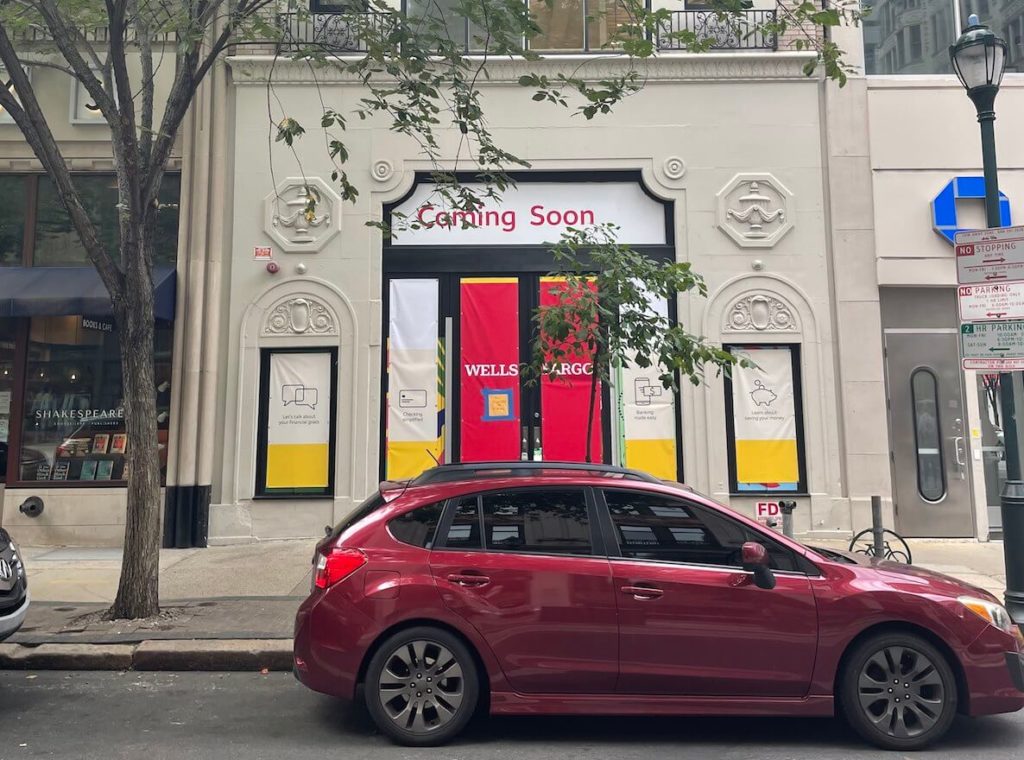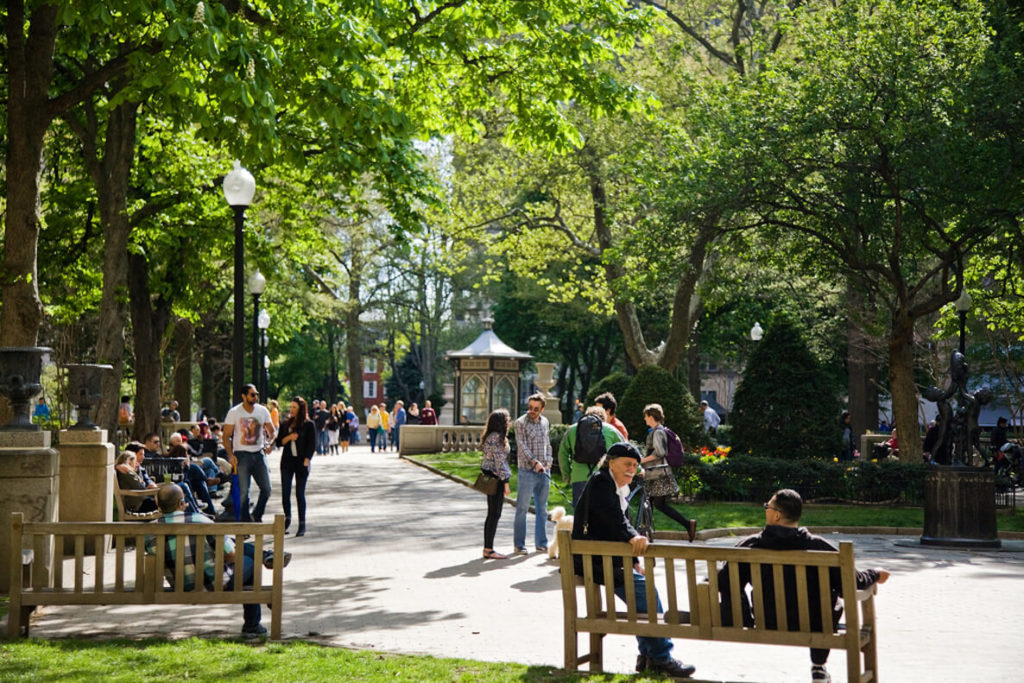We have to stop Walnut Street from being taken over by banks
Aug. xi, 2021
For the final 7 years, I have sat at the same café tabular array. I have told myself that the corner tucked inside the Capitol One's Pete's Coffee concept is my productive place with its south-facing windows and gentle coffee grinder hum. In truth, I sit for the endless parade of iv-legged passersby on the intersection of 17th and Walnut streets.
These days, in that location is no terminate to the putter breeds—burma-doodles, golden doodles, muttadoodles, every poodle-mix imaginable. A skillful afternoon includes a lethargic shar-pei or grumpy bulldog. Occasionally, a dramatic and overheated corgi needs to exist carried home. A not bad viewing afternoon is an endless tangle of leashes and substitution of man apologies as canines cantankerous paths and sniff rear-ends.
What is lost when a block becomes less vibrant and interesting? Are there just less huskies crossing the street or is there a loss of connection from sidewalk encounters, that collectively and in time, work to exist places of connection and even piece of work to eliminate our bias?
However, the frequency of canine entanglement is irresolute as the corridor itself declines.
Even though at that place are far more dogs (the only good affair to come out of the pandemic) in the city than years' past, fewer dogs cross the intersection. There's no reason for human companions to cross over Walnut due to the loftier number of commercial vacancies and current utilise.
A large swath of Walnut was demolished afterwards a fire last summer, while countless retailers, including Gap, Ulta Dazzler, Talbots, Ann Taylor, and H&Yard, closed their doors following the pandemic. (Notably, a few high-end retailers like Barney'southward and Intermix closed downward before the pandemic.) In their absence, banks have become ane of the main fixtures in the landscape. To appointment, iii of four corners of the decorated intersection take been causeless by banks. Another, Santander, is only a few doors down.

The Center City District provides pedestrian counts for loftier-trafficked intersections in the area. The near contempo count from March shows that just 7,317 pedestrians trafficked this intersection. That is less than half (18,348) from March 2019, pre-Covid, and about 3,000 less than the count for September 2022 (ten,052), right in the middle of it.
Recently bored with my reading and awaiting dogs to pass through the intersection, I was alarmed past advertisements for a Wells Fargo in the sometime location of Lucky Jeans. The changing intersection is an ominous warning of the monotonous city that awaits us if variety of use is not prioritized.
The future of Center City Westward necessitates that Walnut Street remain interesting. That means lively streets that generate continuous foot traffic from a diversity of consistent and mixed uses—restaurants, Rittenhouse Square, professional and artistic agencies, in addition to retail. These various uses go along a abiding catamenia of pedestrian (and canine!) traffic on the sidewalk at all times and makes the street vibrant.
Like clockwork, past 9 each morning, early-morning concern commuters are replaced by nannies and strollers. Effectually 10, tardily-morning yogis kickoff making the return home with their mats. Afterward a lull effectually 11, streets crowd with a sea of oxfords in every hue as professionals walk to luncheon. Afternoons are filled with students and shoppers. Truly, the continuity of pedestrian movement is based on converging mixed uses.
Equally William Whyte, urban sociologist and writer of Metropolis reminds united states, "What attracts people most, it would announced, is other people." While the Center Urban center District'southward pedestrian counts do non differentiate between the direction of pedestrian traffic (north/due south versus due east/w), it is clear that fewer individuals are crossing Walnut. Instead of zig-zagging downward the corridor on Rufus' walk to selection upwards coffee, yet another pair of sneakers (bad Rufus!), and a altogether gift for Rufus' friend Jake, the Jack Russell, one simply walks through the commercial corridor to Rittenhouse Foursquare.

There is no reason to cross the commercial corridor. Noted urbanist and author of The Life and Expiry of the Slap-up American City, Jane Jacobs, points out that urban spaces can deteriorate as they lose their sources of vibrancy: "Whichever one of few uses accept emerged as the almost profitable in the locality will be repeated and repeated, crowding out and overwhelming less profitable forms of utilize".
Understanding diversity in terms of physical use and purpose, interesting places, similar Walnut Street, cease to be a describe when deadening and monotonous establishments—in this case banks—hoping to capitalize on foot traffic, colonize the space and button out the original sources of diversity and attraction. It is why simply Vince remains equally a retail spot on the northwest corner of the intersection. Without retail and its resulting foot traffic, the corridor is no longer a destination of involvement unto itself. Instead, information technology exists every bit merely a thoroughfare.
While a staunch urbanist would argue that many of the chain stores point to already existing homogeneous landscape, many, including Lululemon, Athleta, and Warby Parker, function every bit sources of vibrancy since there are no other commercial locations in the city. We do not take multiple commercial corridors like Fifth Artery, Madison Street, or Canal Street like New York City.
Certainly I am non the simply woman who remembers leaving Rittenhouse Square each evening past 9? Like the game of Jenga, city uses are interdependent. Pull out i piece and the whole structure totters.
Though one could argue that nearby amenities such as Rittenhouse Square and the quantity of downtown residences will go along the area vibrant, a quick trip down memory lane is a reminder of the essentiality of retail and of the mundane hereafter that could await the expanse if we just rely on highest and best use.
Retrieve what Center City was like when many storefronts were airtight downwards post-obit the financial recession only 10 short years ago? The vacancies on Walnut Street quickly spilled over to Anecdote Street as well. Not only was there an absence of retail, there was a loss of secondary establishments similar fitness boutiques and salons that thrived on foot traffic. This converging foot traffic at all hours of the day made the expanse not only interesting simply safe.
Certainly I am non the only woman who remembers leaving Rittenhouse Square each evening past nine? Similar the game of Jenga, metropolis uses are interdependent. Pull out one slice and the whole structure totters. Retail makes the area attractive to young creatives, which in plow attracts firms (à la Richard Florida), which in turn, makes the expanse prime number for restaurant concepts like Parc and The Dear which, in plow, generates more foot traffic at the park at night. In the end, it turns out that the park is only as effective as the multifariousness of its adjacent uses.
What is lost when a cake becomes less vibrant and interesting? Are there simply fewer huskies crossing the street or is there a loss of connection from sidewalk encounters, that collectively and in time, work to be places of connection and even work to eliminate our bias equally Elijah Anderson describes in Cosmopolitan Canopy?
Heart Metropolis West notwithstanding has potential to be a vibrant place of connection. Information technology is close to mass transit and major universities. It is surrounded by robust residential neighborhoods. During lunch hour, masked lawyers and real estate agents nevertheless scurry to pick upward their Chipotle orders while Temple and Penn students pick up '90s flannel-wares at Urban Outfitters' flagship store. However, in order to sustain this social tapestry, nosotros need to make interesting streets a priority and long-term goal for the area.
MORE ON COMMUNITY REVITALIZATION IN PHILADELPHIA
-
- How to brand the Benjamin Franklin Parkway 1000 over again
- N Broad will never be the Avenue of the Arts—and that'southward a good matter
- This collaboration of local orgs is working to boost concern in Kensington
- Half-dozen years in, and the Bok is so much more than it ever dreamed of being
How can this exist accomplished? First, there needs to be advocacy and awareness of the importance of the commercial area. When local leaders did non respond to the large-scale looting and vandalism of the commercial corridor terminal summertime, information technology invariably signaled to the retail industry that commercial businesses were not safe in Philadelphia.
Second, encourage long-term planning for the area when prospecting tenants for vacant property, fifty-fifty if information technology means incremental growth. "[Nature's systems] develop strength and resiliency," points out StrongTowns, a recall tank dedicated to creating financially resilient towns, "through a pattern of incremental growth and adaptation. This is truthful for a culture growing in a petri dish or a rainforest with its many unlike flora and fauna. The club of these systems emerge from many complex interactions and adaptations." Beyond banks and, increasingly, cell phone companies, what will bring a longevity of interest to the area?
Let me be articulate, I exercise non blame developers for the process of homogenization—it is extremely difficult to get commercial tenants in the wake of Covid. Notwithstanding, best use should consider longevity of the corridor as opposed to the efficiency of "highest and all-time utilise."
Lastly, incentivize interest in the area with events beyond boozy Middle City Sips—food truck nights, small business pop-ups, domestic dog nights, taco nights, domestic dog and tacos nights… the listing goes on. We have to ask ourselves: what exercise we want downtown to exist in ten years… for our dogs?
Lydia Kulina-Washburn is an educator in Philadelphia, where she lives. Her writing explores the intersection between education and place-making and has been featured in StrongTowns and NextCity. When not writing, Lydia is often walking her goldendoodle. Y'all tin follow her here .
The Citizen welcomes guest commentary from community members who stipulate to the best of their power that it is fact-based and not-defamatory.
RELATED
Finding More Ways To Say Yes
A Covid-19 Success Story
Mystery Shopper: Reporting Illegal Dumping in Philadelphia
Header photo courtesy Visit PhillyFighting Criminal offence Through…Habitation Repairs?




piguenitlierearmeng.blogspot.com
Source: https://thephiladelphiacitizen.org/walnut-street-banks/